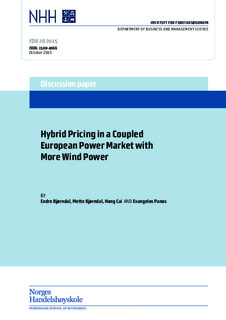Hybrid Pricing in a Coupled European Power Market with More Wind Power
Working paper

Åpne
Permanent lenke
http://hdl.handle.net/11250/2358294Utgivelsesdato
2015-10-28Metadata
Vis full innførselSamlinger
- Discussion papers (FOR) [566]
Sammendrag
In the European market, the promotion of wind power leads to more network congestion.
Zonal pricing (market coupling), which does not take the physical characteristics of transmission into account, is the most commonly used method to relieve congestion in Europe. Zonal pricing fails to provide adequate locational price signals regarding the energy resource scarcity and thus creates a large amount of unscheduled cross-border flows originating from wind-generated power, making the interconnected grid less secure. Prior studies show that full nodal pricing works better in integrating wind power into the grid. In this paper we investigate the effects of applying a hybrid congestion management model, i.e. nodal pricing model for one country embedded in a zonal pricing system for the rest of the market. We test how nodal pricing works in such a hybrid context with more wind power. We find that, compared to full nodal pricing, hybrid pricing fails to fully utilize all the resources in the network and some wrong price signals might be given. However, hybrid pricing still performs better than zonal pricing. The results from the hybrid pricing model of Poland, Germany, Slovakia and the Czech Republic show that, within the area applying nodal pricing (Poland), better price signals are given; the need for re-dispatching reduces; more congestion rent is collected and the unit cost of power is reduced. The results also show that international power exchange increases between the nodal pricing area and the zonal pricing areas, especially on windy days. Moreover, the nodal pricing area has less unscheduled crossborder power flow from the zonal pricing area entering its network and collects more cross-border congestion rent.